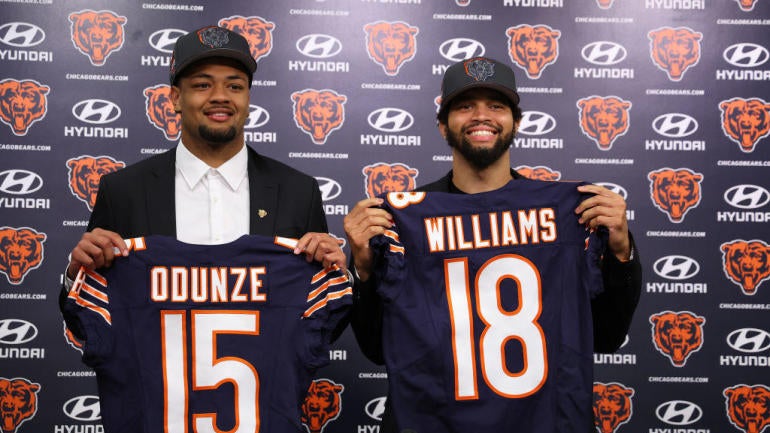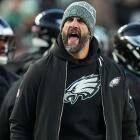Agent's Take: 2024 NFL rookie contract projections for key Round 1 picks, with wage scale explainer
Here's everything you need to know about 2024 rookie deals

A handful of 2024 draft picks will sign their contracts over the next couple of days, which coincides with the start of rookie minicamps. NFL teams will hold a three-day rookie minicamp either this weekend (May 3-5 or May 4-6) or next weekend (May 10-12).
The Baltimore Ravens have gotten the ball rolling by signing 30th overall pick Nate Wiggins, second-round pick Roger Rosengarten, fourth-round pick TJ Tampa and seventh-round pick Sanoussi Kane. Wiggins' fully guaranteed four-year rookie contract should be worth $12,819,824, which includes a $6,143,508 signing bonus. Expect at least a quarter of the draftees to sign contracts within two weeks of the draft's completion.
Here's a look at the deals a select group of first-round picks other than Wiggins are expected to sign. An explanation of how the rookie wage scale operates as well as a discussion highlighting important considerations or issues relating to the first-round contracts follows.
2024 Salary | Signing | 4 Year | |||
Pick | Player | Team | Cap number | Bonus | Total |
1 | $7,179,283 | $25,537,132 | $39,486,057 | ||
2 | $6,863,027 | $24,272,108 | $37,746,649 | ||
3 | $6,661,775 | $23,467,100 | $36,639,763 | ||
4 | $6,431,771 | $22,547,084 | $35,374,741 | ||
5 | $6,029,262 | $20,937,048 | $33,160,941 | ||
6 | $5,310,500 | $18,062,000 | $29,207,750 | ||
7 | $4,735,489 | $15,761,956 | $26,045,190 | ||
8 | $4,160,479 | $13,461,916 | $22,882,635 | ||
9 | Bears | $4,131,727 | $13,346,908 | $22,724,499 | |
10 | $3,973,599 | $12,714,396 | $21,854,795 | ||
12 | $3,384,212 | $10,356,848 | $18,613,166 | ||
13 | $3,297,961 | $10,011,844 | $18,138,786 | ||
15 | $3,096,708 | $9,206,832 | $17,031,894 | ||
21 | $2,722,950 | $7,711,800 | $14,976,225 | ||
24 | $2,607,947 | $7,251,788 | $14,343,709 | ||
27 | Cardinals | $2,521,696 | $6,906,784 | $13,869,328 | |
32 | $2,246,759 | $5,807,036 | $12,357,175 |
How rookie wage scale operates
The rookie wage scale is essentially a salary cap within the overall salary cap. The increases in rookie salaries from one draft class to another are primarily tied to growth of the salary cap. Signing bonuses are going up 3.79%, which is the biggest increase since 2019. The increase had been 1% for each of the last three years because the NFL and NFLPA agreed in 2020 to borrow money from future rookie wage scales to keep 2021 rookie deals from decreasing because of the 2020 revenue shortfall caused by COVID-19.
There's a league-wide limit on the total amount of compensation for rookies with specific salary parameters for each draft slot. Teams have maximum and minimum amounts that can be spent on their picks based on draft position.
All contracts for draft choices are four years. Each pick in the draft has a salary floor and ceiling in the first year and over the four years of the contract. There are very few negotiable items with rookie contracts anymore. The salary components of a deal are restricted to signing bonus, base salary, roster bonus, reporting bonus, workout bonus and select incentives. The type of salary escalators and incentives that used to be responsible for salaries skyrocketing at the top of the draft are prohibited under the rookie wage scale. A majority of picks only have signing bonus and base salaries in their deals.
An extremely important aspect of these deals is the first-year salary cap number (also known as the rookie pool number) because it helps determine the overall value of a contract. The first-year cap number or rookie pool number consists of the player's prorated amount of signing bonus and the rookie minimum base salary, which is $795,000 in 2024.
The maximum annual increase in each of the four years of a deal is 25% of the first-year cap number. To illustrate this concept, 2023 26th overall pick Dalton Kincaid's cap numbers were limited to a $610,320 increase in each year of his deal because his first-year cap number was $2,441,280. Since all of these deals have minimum base salaries in the first year, the remainder of the contract is derived within these constraints.
Draft-pick contracts can't be renegotiated until the conclusion of a player's third NFL regular season. This means the earliest Kincaid's deal can be redone is in January 2026.
Teams have an option for a fifth year with first-round picks that must be exercised after the third year of the deal. The period for exercising fifth-year options begins after a player's third NFL regular season ends (Jan. 8, 2024 with the 2021 first-round picks). These options must be picked up prior to May 3.
The 2020 NFL Collective Bargaining Agreement changed how fifth-year options operate. The fifth-year salary is fully guaranteed when the option is exercised. A player's fourth-year base salary becomes fully guaranteed when the option year is picked up if it wasn't already.
The fifth-year salaries are no longer strictly tied to where a player was drafted (i.e.; top 10 or outside of top 10). Performance dictates the option-year salaries. With two or more Pro Bowl selections on the original ballot during the first three seasons of contracts, the fifth-year salary is the franchise tender, which is the average of the five highest salaries for a player's position in the fourth year of his contract. For example, 2021 fifth overall pick Ja'Marr Chase's fifth-year option with the Cincinnati Bengals for 2025 is the 2024 franchise tender for wide receivers, which is $21.816 million, because he was selected to the Pro Bowl on the original ballot in each of his three NFL seasons.
One Pro Bowl selection on the original ballot during the first three seasons of deals puts the fifth-year salary at the transition tender, which is the average of the 10 highest salaries for a player's position in the fourth year of his contract. Los Angeles Chargers offensive tackle Rashawn Slater falls into this category. Slater's fifth-year option in 2025 is $19.04 million, the 2024 transition tag for offensive linemen.
Participating in 75% of offensive or defensive plays, whichever is applicable, in two of the first three seasons of deals or an average of at least 50% playtime in each of their first three seasons, sets the fifth-year salary at the average of the third through 20th highest salaries at a player's position. For first-round picks who don't fall into any of these three categories, the fifth-year salary is the average of the third through 25th highest salaries at a player's position.
The Proven Performance Escalator which increases the fourth-year salary for third- through seventh-round picks now also applies to second-round picks and is more expansive with higher playtime thresholds.
Third- through seventh-round picks still have a salary escalator for their fourth year based on participating in a minimum of 35% of the offensive or defensive plays, whichever is applicable, in two of the first three seasons of their deals or an average of at least 35% playtime in their first three seasons. The salary equals the original draft round restricted free agent tender in the fourth year. The number is $3.116 million this year. With second-round picks, the required playtime is 60% in two of the first three seasons of their contracts in order for the fourth year salary to be at this level.
The fourth-year salary for second- through seventh-round picks increases to the original draft round restricted free agent tender in that specific year, plus $250,000 with at least 55% offensive or defensive playtime in each their first three seasons of the contract. That number for 2024 is $3.366 million. Fourth-year salary will elevate to the second-round restricted free agent tender with at least one Pro Bowl selection on the original ballot in the first three years of a rookie deal. The second-round restricted free agent tender is $4.89 million this year.
Negotiable items
There are very few negotiable items with rookie contracts anymore. The two primary negotiating issues, particularly at the top of the draft, are the payment schedule of the signing bonus and whether salary guarantees will have offsets. Another important consideration is the language outlining the voiding of salary guarantees.
A majority of rookies didn't sign contracts until the latter part of July as training camp approached before the rookie compensation system was overhauled in the 2011 CBA. In 2010, no player selected in the first two rounds had signed by July 4. First-round picks holding out wasn't unusual either. For example, 2007 first overall pick JaMarcus Russell held out for 47 days before signing with the Oakland (now Las Vegas) Raiders. Rookie holdouts are largely a thing of the past.
The Chargers and third overall pick Joey Bosa engaged in the longest contract dispute for an incoming NFL player under the rookie wage scale in 2016. Bosa was the first rookie since 2013 who didn't show up to training camp on time. He missed 31 days before signing his contract.
The Chargers and Bosa weren't disagreeing over the amount of money in his contract because the total value was dictated by the rookie wage scale's constraints. The dispute was largely over the payment schedule of Bosa's signing bonus, the inclusion of roster bonuses and related language if the deal contained offsets. A major concession the Chargers made to Bosa was a better payment schedule than they typically give to players with big signing bonuses.
Linebacker Roquan Smith, 2018's eighth overall pick, missed the first two weeks of training camp because he and his agents objected to language where the Chicago Bears had the right to void his guarantees for an ejection or suspension from a game for violating NFL playing rules. A compromise was reached on the number of games in a suspension necessary to trigger voiding.
An offset clause allows a team to reduce the guaranteed money owed to a player when he is released by the amount of his new deal with another team. The player receives his salary from the team that released him in addition to the full salary from his new contract with another club when there isn't an offset (also known as "double dipping").
Agents have essentially lost the battle on offsets. Teams with early first-round picks in 2013 were adamant that contracts contain offsets after largely conceding the issue the previous year. As a compromise for top-10 picks, teams structured deals with minimum base salaries in the final three years where the remainder of a player's salary is in annual fully guaranteed third or fifth day of training camp roster bonuses.
Nearly every team besides the Jacksonville Jaguars and the Los Angeles Rams require offsets with salary guarantees for draft picks, including those selected in the top 10. Based on past practices, 19th overall pick Jared Verse's and 23rd overall pick Brian Thomas Jr.'s respective contracts with the Rams and Jaguars shouldn't contain offsets.
A quarterback has the best chance of extracting a concession on offsets than players at other positions. Mitchell Trubisky, the second overall pick in 2017, signed a deal with the Bears where his $465,000 2017 base salary and training camp roster bonuses in 2018 through 2020, which contained most of the money in the last three years of his contract, didn't have offsets. His league-minimum base salaries in the last three years of his contract had offsets.
The only other Bears first-round pick under the rookie wage scale to get a concession like Trubisky was another quarterback, Justin Fields. As 2021's 11th overall pick, Fields got the similar treatment as his 2017 predecessor. His $660,000 2021 base salary and 2022 through 2024 training camp roster bonuses don't have offsets. Fields had a minimum base salary in 2022 with the rest of his money in a training camp roster bonus. His compensation in both 2023 and 2024 is split evenly between base salary and a training camp roster bonus.
Caleb Williams, the 2024 first overall pick, shouldn't be treated worse than Fields with offsets. It wouldn't be surprising for Williams to insist that all of his guarantees have no offsets since he was drafted higher than Trubisky and Fields.
More players throughout the first round are pushing for training camp roster bonuses with base salary no longer paid over the course of the 18-week regular season. Training camp roster bonuses are typically paid by the end of August at the latest. Beginning in 2021, base salary started being paid over a period of 36 weeks (twice the number of regular-season weeks).
Chiefs' Trent McDuffie, the 21st overall pick in 2022, was the last player taken in the first round to have any training camp roster bonuses. Training camp roster bonuses extended to Vikings' Jordan Addison, last year's 24th overall pick.
Large signing bonuses in NFL contracts aren't typically paid in one lump sum. This is a long-standing practice in the NFL. Signing bonuses for top draft picks have typically been paid in multiple installments.
Lump-sum payments are starting to become more accepted at the top of the first round. Generally, quarterbacks have been more successful in getting signing bonus paid in its entirety shortly after signing. That was the case last year with Panthers' Bryce Young, Texans' C.J. Stroud and Colts' Anthony Richardson, who were the first, second and fourth overall picks.
Quarterbacks were the first three picks in this year's NFL Draft. Jayden Daniels and Drake Maye were taken second and third overall, respectively, by the Commanders and Patriots after the Bears selected Williams. The last time quarterbacks went first, second and third overall was in 2021.
The Jaguars made a big departure from their customary signing bonus payment schedule with 2021 first overall pick Trevor Lawrence. His entire $24,118,900 signing bonus was payable within 15 business days of signing. Zach Wilson and Trey Lance, the second and third overall picks, got their $22,924,132 and $22,163,824 signing bonuses paid in a lump sum, respectively, by the Jets and 49ers. Receipt of the money was in a similar timeframe as the first overall pick's signing bonus. Expect the same thing with Williams, Daniels and Maye.
Wide receiver Marvin Harrison Jr. will likely have a difficult time getting his signing bonus paid like Richardson's. The quarterback received his $21,722,932 signing bonus within 15 days of executing his contract with the Indianapolis Colts last July. A non-quarterback taken after the second overall pick has never gotten his signing bonus in a lump sum.
It would also require the Cardinals to establish a new precedent with signing bonus payments. The last team that paid the signing bonus of the first overall pick in installments was the Cardinals with quarterback Kyler Murray in 2019 as $16.75 million of Murray's $23,589,924 signing bonus was paid on June 3, which was a little more than three weeks after his contract was executed. The remaining $6,839,924 was deferred until March 1, 2020.
Harrison getting his signing bonus paid in similar fashion as 2023 third overall pick Will Anderson Jr. would be tremendous progress. The edge rusher received $19,217,922 (or 85%) of his $22,609,320 signing bonus from the Texans within 15 days of signing. The remaining $3,391,398 was paid to him Oct. 15.

















